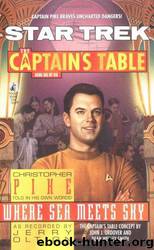Where Sea Meets Sky by Jerry Oltion

Author:Jerry Oltion [Oltion, Jerry]
Language: eng
Format: epub
Publisher: Pocket Books/Star Trek
Published: 2012-07-13T17:36:38+00:00
Eighteen
… SO WE DIDN’T have much time to wonder what we’d find. Of course we had trouble even before we got there. Titan bodies kept looming up in the sensors, and Number One kept having to dodge them at warp speed all the way across from star to star. They must have eaten every source of raw materials in both systems every moon, every asteroid, every meteor and then they had spread out to eat the comets. And those weren’t in a nice flat plane, so we couldn’t even rise up over them the way we had deeper in-system.
We slowed to warp six, then to warp five, and on down the scale as the titan density increased. Spock scanned ahead with long-range sensors and found the gaps where planets had swept their orbits clean, and we aimed for the first of those, dropping back into normal space just a few light-minutes from the outermost planet.
At first glance it looked like a terrestrial world, not much larger than Earth. It was too far from its sun even a brighter F6 like this one to ever support humanoid life, but it showed definite signs of titan influence. Their bodies littered the surface here, too, though we found no young ones this time. There were a great many unhatched eggs, all split open from impact. The cause was readily apparent: there was no atmosphere left at all to slow their fall.
I couldn’t see any evidence that this planet had ever had continents or oceans. It looked more like Mars than Earth, only much darker and without the heavy cratering that Mars endured. I wondered why it hadn’t been bombarded by asteroids early in its life, but Spock soon gave me the answer.
“Fascinating,” he said, finally looking up from his monitors. “This planet used to be a gas giant.”
“What?” I asked. “How could that be? It’s bare rock now.”
“This is the core of a class-S planet, much like your Saturn. It did at one time have a metallic hydrogen envelope surrounding it and a gaseous hydrogen and helium atmosphere, but that appears to have been entirely removed by the titans, as have the atmospheres of all the planets inward from here. When I calculate the mass removed and compare it to the estimated mass of the titans in both star systems, I find that the two figures agree within three percent.”
“My god,” said Number One. “They completely stripped the planets.”
“Take us inward,” I told her. “Let’s see what else they’ve done.”
Now that we were within the planetary disk, where gravitational perturbation would keep loose bodies in the plane of the ecliptic, we could rise above the rings of titan bodies and move steadily inward, scanning the planets as we went. The next two were just like the first, rocky cores of what had once been huge gasballs, but the fourth one had the familiar characteristics of a class-M planet. It still held its atmosphere, probably because nitrogen and oxygen weren’t useful to the titans
Download
This site does not store any files on its server. We only index and link to content provided by other sites. Please contact the content providers to delete copyright contents if any and email us, we'll remove relevant links or contents immediately.
Sita - Warrior of Mithila (Book 2 of the Ram Chandra Series) by Amish(53866)
The Crystal Crypt by Dick Philip K(36459)
Cat's cradle by Kurt Vonnegut(14784)
Always and Forever, Lara Jean by Jenny Han(14498)
Ready Player One by Cline Ernest(14033)
The Last by Hanna Jameson(9828)
Year One by Nora Roberts(9332)
Persepolis Rising by James S. A. Corey(8998)
The remains of the day by Kazuo Ishiguro(8418)
Never let me go by Kazuo Ishiguro(8338)
Red Rising by Pierce Brown(8288)
Dark Space: The Second Trilogy (Books 4-6) (Dark Space Trilogies Book 2) by Jasper T. Scott(7941)
The handmaid's tale by Margaret Atwood(7470)
The Circle by Dave Eggers(6851)
Frank Herbert's Dune Saga Collection: Books 1 - 6 by Frank Herbert(6731)
The Testaments by Margaret Atwood(6526)
Legacy by Ellery Kane(6405)
Pandemic (The Extinction Files Book 1) by A.G. Riddle(6204)
Six Wakes by Mur Lafferty(5847)
